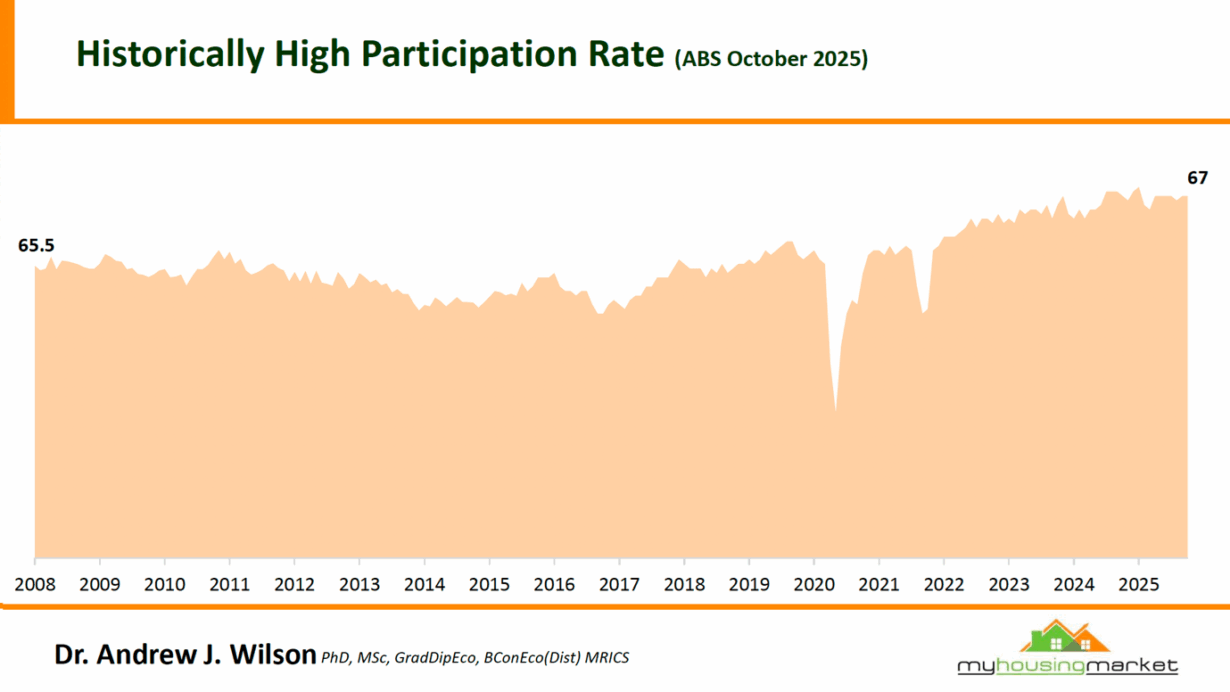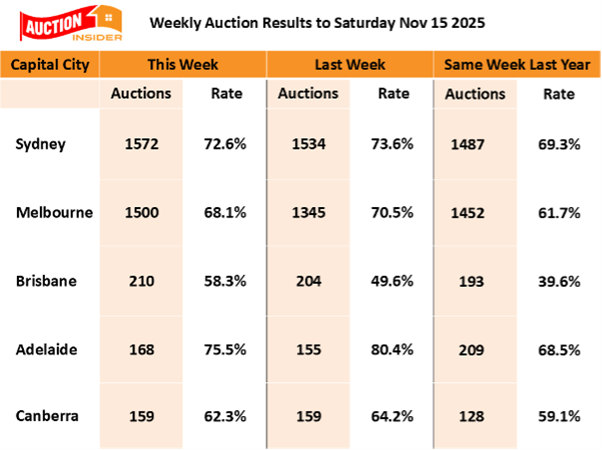
Key takeaways
The drop in unemployment to 4.3% – driven by a surge in full-time jobs – confirms the labour market is still running hot.
A strong jobs market keeps inflation sticky, which gives the RBA zero incentive to ease early.
A 12.5% monthly rise in building approvals sounds positive, but it’s masking the structural reality.
Building approvals are still well below long-term averages – houses down ~26% from peak and units down over 40%.
With Australia simply not building enough homes, the fundamentals continue to support price resilience.
This imbalance – particularly acute in the capitals – will keep upward pressure on rents and values, especially for scarce, investment-grade asset.
Spring has brought more listings and slightly softer clearance rates, but there’s no evidence of distress.
Demand still exceeds supply in most suburbs, and well-located properties with strong fundamentals are selling quickly and competitively.
Hopes of another rate cut anytime soon have nosedived after the unemployment rate fell last month, adding to evidence that inflation pressures remain in the Australian economy.
The drop in the jobless rate from 4.5 per cent in September to 4.3 per cent in October came after the number of employed people rose by 42,000 people, well above expectations.
In this week’s Property Insiders chat Dr. Andrew Wilson and I look at what the latest unemployment figures mean for property buyers, sellers, and investor sentiment.
There is a complex mix of data. A resilient labour market is pushing expectations of rate cuts further out, even as emerging pockets of weakness suggest inflationary pressures may ease sooner than some forecasters anticipated.
We also discuss the latest home building approval figures and what they mean for our tight housing markets, as well as how our auction markets performed over the weekend.
A jobs market that refuses to slow down
Despite constant predictions that higher interest rates would break the back of the labour market, the opposite is happening.
Watch this week’s Property Insider chat as Dr Andrew Wilson explains the October unemployment rate fell from 4.5 to 4.3 per cent, driven by a sharp rise in full-time jobs.
Total employment lifted by 42,000 people, including a stunning 55,000 increase in full-time positions.

That’s not the sign of an economy buckling under rate pressure – it’s an economy that’s still running hot.
Even more telling is the participation rate. At 67 percent, it sits near record highs. That means Australians aren’t retreating from the workforce – they’re staying engaged, confident, and employed.

This matters because a strong labour market keeps inflation sticky. Wages remain firm, spending holds up, and businesses keep hiring.
In simple terms: don’t expect rate cuts anytime soon.
As Andrew points out, the better the labour market performs, the more patient the RBA will be.
And with WA and Queensland posting the lowest unemployment rates in the country, resource-driven states continue to show remarkable resilience.

The building approvals ‘bounce’ that isn’t a recovery
Watch this week’s Property Insider chat as Dr Andrew Wilson explains how on the surface, a 12.5 percent monthly jump in home-building approvals looks encouraging.

But the headline hides the deeper structural problem.
Approvals are still dramatically below where they need to be.

Yes, units jumped 26 percent in September and house approvals rose slightly, but overall volumes remain well below historic averages.
When you look at the long-term trend charts, approvals in our capital cities are still down around 26 percent from the 2016 peak.

For units, the drop is even more concerning – down more than 40 percent compared to that peak.

This shows a long-term undersupply story which is colliding head-on with the strongest population growth in decades.
Victoria showed the biggest monthly increase, up 41.3 percent, but even that looks more like volatility than a turning point.
The annual figures remain depressed, and the pipeline is still nowhere near the levels required to fix Australia’s housing shortage.
This tells investors something very simple: The supply squeeze isn’t going away any time soon.
If anything, it’s worsening.
Spring auctions: more stock, slightly softer clearance rates
We’re now deep into the spring selling season, and auction volumes surged again over the weekend.
More choice for buyers means more competition for sellers – and clearance rates eased as expected.

Nothing in these numbers points to a market in trouble. If anything, the resilience is remarkable considering high interest rates and rising stock.
Buyers are becoming more selective, but they’re still active.
Sellers are realistic. And despite more listings hitting the market, demand continues to exceed supply in most locations.
So what does all this mean for property investors?
Here’s the big picture:
1. Rate cuts are further away than many hope
A strong labour market gives the RBA every reason to delay easing until they’re absolutely confident inflation is anchored.
Don’t build your strategy around cheaper money in early 2026.
2. Housing supply will remain constrained for years
Even with a monthly bounce, approvals are far too low to meet long-term demand.
This sets the stage for continued upward pressure on rents and prices.
3. Quality assets will outperform
In a tight, low-supply environment, investment-grade properties in desirable, land-locked, high-amenity suburbs will continue to attract competition.
4. The market is now more segmented
Auction clearance rates show solid, stable demand, but buyers are being discerning.
Properties with compromises are struggling; properties with scarcity value are selling strongly.
5. Investors who buy countercyclically will be rewarded
While others wait for a rate-cut that may arrive much later than expected, strategic investors can take advantage of less competition and secure assets before the next upswing.
The headlines often imply chaos, but the underlying data tells a more coherent story:
- A strong labour market
- A severe shortage of new housing
- Resilient buyer demand
- A rental market under ongoing pressure
Put all of that together, and the outlook for the right type of property remains solid.
As Andrew and I discuss each week, it’s not about trying to time the market – it’s about buying smart, buying well, and focusing on long-term fundamentals.
And right now, those fundamentals are pointing in one clear direction: Australia simply isn’t building enough homes.
That’s a challenge for the nation, but an opportunity for informed property investors.














